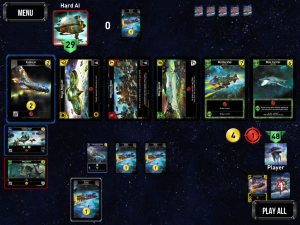Summer Camp has flown under the radar among new games this year because it’s a Target exclusive release (at least for now) and comes from a publisher not known for tabletop strategy titles, Buffalo Games, a publisher of jigsaw puzzles and party games. Yet Summer Camp is from Phil Walker-Harding, the mind behind Cacao, Gizmos, Imhotep, Imhotep: The Duel, and Silver & Gold, and it’s a straight-up deckbuilder, one that – dare I say it – is actually fun for the whole family. It’s so light and breezy for a deckbuilding title that you can play with anyone in the house who reads fluently. Right now, it’s $24.99 on Target.com, although I found it for 10% off in store a few weeks ago.
Summer Camp does have a modular board of 9 tiles that you arrange randomly in a 3×3 grid at the start of each game, forming three paths across the board, left to right, that your campers will try to traverse as you play. Each path is tied to a specific activity – Cooking, Water Sports, Outdoors, Friendship, Arts & Crafts – and has merit badges for campers who get all the way to the end of the path before the game ends, with more points for those who get there first. Along the paths, certain spaces give you a one-time bonus, allowing you to move any camper one more spot, to draw one more card into your hand, or to gain one snack bar (+1 energy for purchasing cards).
The heart of the game is your deck, which you’ll build as the game progresses, trying to get more powerful cards to drown out the relatively weak ten cards with which you start the game: seven Lights Out card, which have no value other than their purchasing power of 1 energy; and one card for each of the three paths that allows you to move your camper forward one space. Other than the Lights Out cards, all cards have an action on them – move 2+ spaces, move any camper one space, draw another card, discard & draw, gain 2-4 energy for purchases on this turn, and so on.
On each turn, you draw a fresh hand of five cards from your deck, and at the end of your turn, you discard all cards to your discard pile, shuffling the latter when your deck runs out. All cards have a value of 1 energy if you don’t use them, so you will never have a turn where you can’t do anything – even drawing five Lights Out card lets you buy one or more cards with a total cost of 5. There are also three stacks of generic cards, not tied to any of the separate path decks, that are always available to purchase – S’mores, cost 2, worth +2 energy for purchases; Scavenger Hunt, cost 3, which lets you discard 1-3 cards and draw that many again; and Free Time, cost 4, which lets you move one camper on any track one space forward. That’s a huge part of what makes this game more friendly to younger players and casual gamers – you will never have a wasted turn. You can always buy something, and the cheapest cards to buy are still useful.
There is some light strategy involved in how you move the campers, balancing the points value of getting the merit badges first – when you get all your campers to the first bridge, one-third of the way across the board, you get the top badge in that pile, and there’s another pile worth more points when you get all your campers to the second bridge – against the value of getting to the end of a path first. You also may move certain campers to trigger those space bonuses, especially the one where you get to draw another card, which can keep your chain of moves moving or just get you more buying power. If there’s a best way to build a deck here, I haven’t caught on to it yet; there is no card anywhere in the game that lets you trash any cards (like the Chapel card in Dominion), and the fact that only two cards are available from each path deck at any given time makes it very hard for one player to monopolize a good card or build a deck full of a specific type of card. That serves to balance things out, and may frustrate experienced players who like deckbuilders that give you more control, but for a game that is clearly aimed at family play – right down to the theme – it makes perfect sense. It’s great for ages 8+ and the box’s suggested play time of 30-45 minutes is about right once everyone gets the deck concept.


